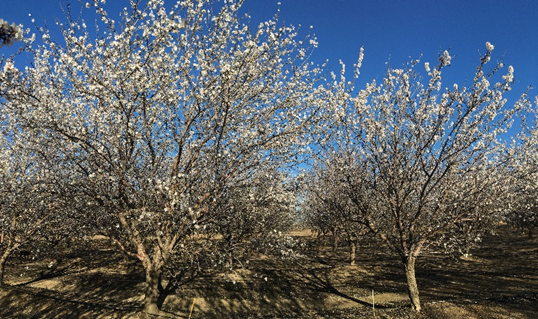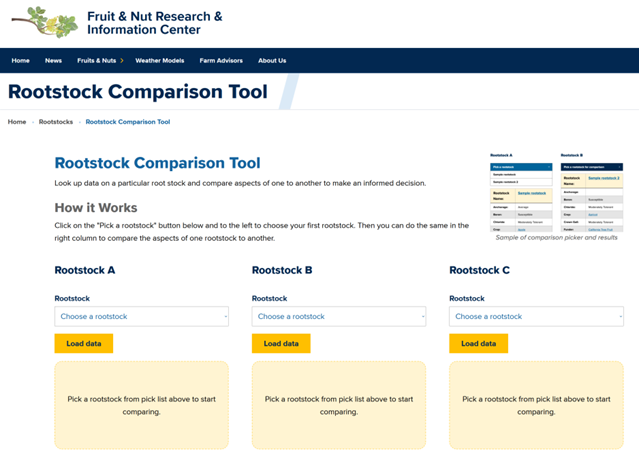Kat Jarvis-Shean, UCCE Sacramento, Solano and Yolo Counties
Selecting a rootstock when developing an orchard is a decision that will impact tree health and yield for the rest of the life of the orchard. Rootstocks can help mitigate the impact of site-specific conditions, both abiotic stressors like toxic boron or chloride in the soil or water and biotic stresses like Phytophthora or nematodes in the soil. Rootstocks also impact horticultural characteristics of the tree, like anchorage and vigor. The University of California has spent decades testing rootstocks in greenhouses, lath houses and grower fields to understand their strengths and limitations. UC Cooperative Extension has recently compiled the lessons from those trials into one comprehensive ranking table (https://fruitsandnuts.ucdavis.edu/sites/g/files/dgvnsk12441/files/inline-files/Almond%20Rootstocks.pdf, Fig 1) and an online comparison tool (https://fruitsandnuts.ucdavis.edu/rootstocks/rootstock-comparison, Fig 2). The more time you invest early on in understanding the specific conditions of your site and selecting a rootstock based on those conditions, the less you’ll have to invest in managing stressors later in the life of the orchard.

Figure 1. Sample image showing a few of the rootstocks and traits ranked in the new UC Almond Rootstock guide.
Understandably, when selecting a rootstock, it’s tempting to first look for the rootstock that will create the tree with the highest yield. But if there is particular challenges or stressors at your orchard site, picking based on yield results at an unchallenged site is putting the cart before the horse. The first focus should be a rootstock that will stay healthy under the conditions at your site. A sick tree won’t live up to the maximum yields achieved at a pristine, unchallenged site, and will likely require significant additional inputs and management expenses to keep it yielding economically. Understand the one or two main challenges at your site, identify the rootstocks that can help manage those challenges, and then learn other aspects of those rootstocks so you can optimize the performance of trees in your orchard (e.g. plant at tighter spacing for a less vigorous rootstock).
When considering rootstock options, you’ll encounter, roughly speaking, four groupings of different genetic heritage rootstock options: peach, peach-almond hybrids, Myro plum hybrids and complex hybrids (peach-almond-plum-apricot). Similar genetic heritage is often associated with common traits. These guidelines can help orient you to options; however, within categories, there are rankings and there are exceptions, so examine the merits of each specific rootstock. Below I’ll review findings for common challenges in the Sacramento Valley, but for a complete ranking by trait and rootstock, check out the new publication or comparison tool. In the Sacramento Valley, frequent abiotic challenges include excessive chloride and boron, heavy soils that are susceptible to waterlogging, and strong winds leading to leaning trees or blow-overs.
In a decade-long trial in a grower field in western Stanislaus County, UCCE Farm Advisor Roger Duncan consistently found that leaves from cv. Nonpareil trees on the peach-almond hybrid rootstocks Paramount, Brights 5, BB 106, Hansen and FxA, as well as the plum-almond hybrid Rootpac R, remained below the chloride toxicity critical value threshold of 0.3%, while at the same site pure peach rootstocks Lovell and Nemaguard, along with peach-plum hybrid Krymsk 86, often had twice the critical value level in their leaves.
Similarly, at a decade long boron challenged rootstock trial that I led west of Woodland in an orchard with high boron in the soil and water, the peach-almond hybrids Nickels, FxA, Brights-5 and Titan SG1, always outperformed the pure peach rootstock Lovell in both yield and yield efficiency (yield adjusted for tree size, see below), as well as often having significantly lower hull boron values (Figure 3). Krymsk 86 was almost always significantly lower in yield and yield efficiency than the aforementioned peach-almond hybrids, as well.
Rootstocks with plum heritage often have good anchorage to withstand heavy winds. A trial in Kern County found the complex hybrid Viking had only 4% blow-overs following an 85 mph sustained wind coupled with rain. It’s complex hybrid sibling, Atlas had 30% blow-overs. Other trials and anecdotal evidence have shown the plum hybrid Krymsk 86 and the peach-almond hybrids F x A and Hansen 536 to have excellent anchorage as well. Plum hybrids are generally considered to be the most tolerant to winter waterlogging, though it should be noted that wet soil in-season can worsen incompatibility symptoms we sometimes see with certain cultivars and plum heritage rootstocks.

Figure 3. Rootstocks Nickels, a peach-almond hybrid, alongside Lovell, a pure peach, both with cv. Nonpareil as scion.
When it comes to biotic challenges, we know more about disease and nematode susceptibility through researchers screening in greenhouses and small plots where they purposefully infect the plants than from large-scale grower-hosted trials. Frequent biotic challenges encountered in the Sacramento Valley include phytophthora, oak root fungus, verticillium wilt, and root lesion nematode. For phytophthora, the sources of resistance come from plum heritage. Plum hybrids such as Marianna 2624, Krymsk 86 and Rootpac R are the most resistant options, whereas peach-almond hybrids are highly susceptible. It’s safest to assume any orchard that’s been flooded or irrigated with surface water at some point in its history will have phytophthora inoculum present. Attentive irrigation management and site preparation (e.g. berms) may allow growers of even peach-almond hybrids to avoid infection, but on heavy ground with occasional drainage challenges, phytophthora risk should be strongly considered. Similar to phytophthora, for oak root fungus, the source of resistance is found in plum heritage, with plum hybrids Marianna 40 and Marianna 2624 providing the best resistance (though they’ll require a cv. Padre interstem to be grafted below cv. Nonpareil) and Krymsk 86 providing moderate resistance. For verticillium wilt, which we often find in almonds following tomatoes, only Atlas has been found to be tolerant, whereas other rootstocks range from susceptible to highly susceptible. For root lesion nematode, our options are regrettably thin. Only Hansen 536 is moderately tolerant, but tolerance, as opposed to resistance, means it will still allow nematodes to infect, feed and breed on the roots; the tree just won’t suffer as much stunting as a result of the infection. Research is ongoing to test and develop new and better options for these diseases, as well as crown gall and the major almond-infecting nematodes.
Once you understand what, if any, stressful conditions may be present at the site in question, and what rootstocks mitigate the stress of those conditions, then you can consider the vigor of your different options. If you’re lucky enough to be planting a site without significant challenges, you can skip right to this step. Broadly speaking, peach-almond hybrids are highly vigorous, peach and complex hybrids have moderately high vigor and plum hybrids are moderately vigorous. Higher vigor frequently leads to higher yields since trees fill their space well. At Roger Duncan’s westside trial, the trees on pure peach were about 20% smaller than the trees on peach-almond hybrids that were able to tolerate the site’s high chloride and cumulatively over six harvests yielded about 30% less when they were planted at the same spacing. At my Yolo County high boron trial, trees on Lovell were about 20% smaller than the trees on the peach-almond hybrids and yielded only about half as much over the first nine harvests of the trial. At Joe Connell’s northern Sacramento Valley trial, planted in Durham on a wide spacing (16 x 24 feet) in 2010 following an orchard that had been on Lovell, these same trends could be seen. The trees on peach rootstock Lovell, plum hybrid Krymsk 86 and complex hybrid Atlas were about 20% smaller than the peach-almond hybrid Nickels and the peach-wild peach hybrid Empyrean 1, and cumulatively yielded about 25% less than trees on Nickels and Empyrean 1 that had better filled their space over the first eight harvests.
Though higher vigor often results in higher yields, there are some rootstocks that “punch above their weight” when it comes to size and yield. Thus, it also pays to examine ‘yield efficiency’, which is calculated by dividing yield by either the trunk circumference or canopy area, to essentially tell us how much trees are yielding compared to their size. On a yield efficiency basis, for example, Brights 5, a less vigorous peach-almond hybrid, and Viking, a complex hybrid, often yield as much as more vigorous peach-almond hybrids like Nickels. This tells us that at tighter spacings than used at the experimental sites, we would expect these rootstocks to have similar yield. For this level of data specificity, you can consult the results in the annual Almond Board rootstock research reports.
Picking a rootstock when planning an orchard is a tough decision that will impact how much yield an orchard pumps out, what inputs are required, and how much time and effort is needed to keep your orchard thriving. The first step is to know your site – test the soil and water, know the cropping history and any previous disease or nematode concerns. The next step is to select a rootstock that can thrive under the specific conditions of your site. Finally, appreciate the qualities of that rootstock beyond resistance or tolerance to site stressors, and integrate those qualities (e.g. moderate vigor, phytophthora susceptibility, etc.) into your orchard plan (e.g. tighter spacing, berms and attentive irrigation, etc.). New resources created by the University of California with support from the Almond Board can go a long way in helping in this process.



Leave a Reply